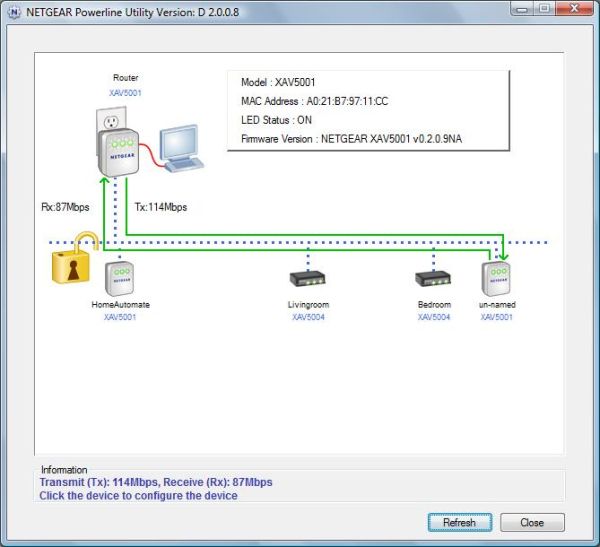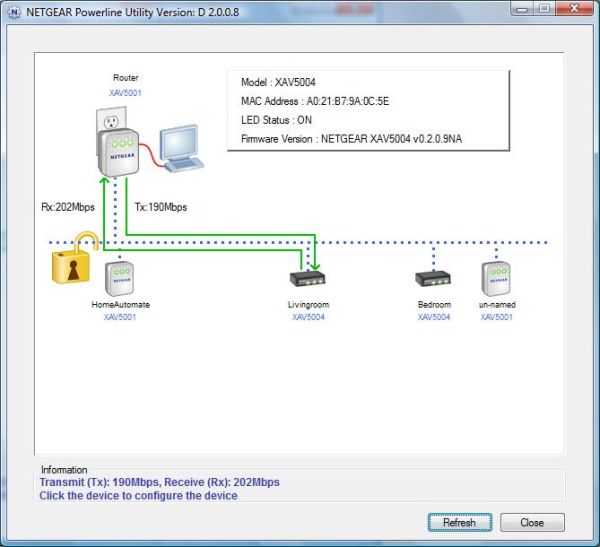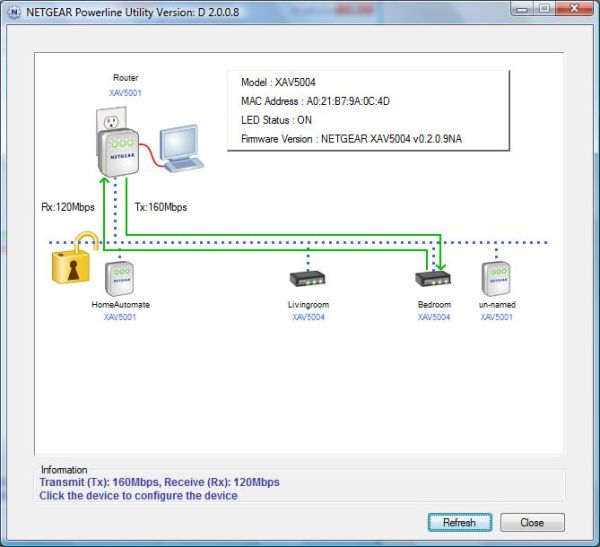Hands-On Powerline Networking: How Well (Or Not) Are Latest-Generation Devices Working?
by Brian Dipert on September 1, 2011 12:41 AM EST- Posted in
- Networking
- Powerline Adapters
- NetGear
I also ran 72 tests' worth of UDP measurements, leveraging the Ixia-supplied UDP_Throughput.scr script as-is in the four-stream case. For single-stream UDP tests, I modified UDP_Throughput. scr, increasing the per-stream data-payload size from 730 KBytes to 7.3 MBytes in order to lengthen the tests' runtimes. After all, as I previously mentioned, newer powerline technologies focused their performance-improvement attention on UDP, which finds use in streaming large-payload multimedia content from one network client to another. And you can find my UDP testing results reports in the earlier-mentioned ZIP archive.
But I've decided not to publish the average bandwidth measurements in a table, as I did one page back with the TCP results. That's because, in every testing case, only a few packets succeeded in making their way from one Endpoint to the other, translating to a near-100% packet loss scenario. To be clear, this underwhelming outcome did not occur due to any inherent HomePlug AV or IEEE 1901 UDP incompatibility; as I type these words, for example, I'm watching a video streamed from a computer to my television over an AR7400-implemented powerline spur and using UDP. But after a few moments' reflection, I came up with a seemingly plausible explanation, which a subsequent chat conversation with Brian Klug sanity-checked and an email back-and-forth with Ixia's Michael Githens confirmed.
The issue, as networking wizards among you out there may have already figured out, is that by definition, UDP is (in the words of Brian Klug) 'connectionless'. This means less protocol overhead, but with UDP being a best-effort approach, it's possible for an abundance of packets to get dropped due to transmission channel bandwidth limitations...that is, unless the transmitter is somehow (at the application layer) able to monitor the receiver's success-or-failure statistics and (if necessary) back off its packet-output rate. Windows Media Center, for example, does this; if necessary, it'll more aggressively compress video (for lower per-frame average bitrate, at the tradeoff of reduced image quality) and/or drop frames in order to match its transmission speed to the channel and receiver's capabilities.
IxChariot unfortunately doesn't seem to include destination-cognizance features such as these. All it seemingly knows is that, for example, the two HomePlug AV adapters I tested are reporting 100 Mbps PHY rate capabilities, with the XAV5001 adapters touting GbE speeds, and it subsequently sends out packets at much faster rates than the powerline spur is capable of reliably routing to their destination. Here's what Ixia's Michael Githens said when I explained my predicament and theory as to its root cause:
Unfortunately there isn't anything built into IxChariot to automatically help you figure out that no-drop rate. You could, however, script it to do a test, check results and change an input value to have it do multiple runs for you so that you can zero in on the no-drop rate. That would be the best I could suggest.
Such an iterative approach is actually something I'd considered, but its tedious and time-consuming aspects make it unattractive for the involved testing suite that I tackled in this project. And unfortunately, Brian Klug reports that iPerf is seemingly similarly destination-unaware in its consequently 'blind' UDP testing approach. I welcome reader suggestions on utilities or other techniques that will measure the peak no-packet-drop UDP bitrate without excessively burdening the source-to-destination channel (thereby under-representing the channel's UDP potential). Applications that are Mac OS X-cognizant are particularly welcome, since the only two GbE-capable laptops in my possession are Macs, neither of which has Windows optionally installed via Boot Camp. Please leave a comment on this writeup, or drop me an email.
For whatever it's worth, I'll wrap up this particular page by passing along the four router-to-node screenshots of 'raw' measured bandwidth potential that Netgear's Powerline Utility (Windows version; here's the Mac edition) measures for my AR7400-based XAV5001-plus-XAV5004 powerline network, from the router-based adapter to each of the four other network nodes.
Node 1
Node 2
Node 3
Node 4














53 Comments
View All Comments
EarthwormJim - Thursday, September 1, 2011 - link
You can typically follow other wiring in the house when retrofitting, like telephone wiring or coaxial wiring.Competition is probably high in my area, I often see several advertised specials from electricians specifically for cat 5 wiring.
bobbozzo - Thursday, September 1, 2011 - link
If you have (wall-to-wall) carpet, it's very easy to lift up the carpet a little and run cat5 under it... I ran a 100' drop in about 15mins.Also, you can get baseboard or crown molding which are gapped or routed (cut out) for wires to be hidden in.
e.g.
http://www.curbly.com/Chrisjob/posts/3618-Hide-you...
http://www.wiretracks.com/prod-cm.html
bobbozzo - Thursday, September 1, 2011 - link
Also, my alarm guy does cat5 drops through the attic for $30 each, which is a real bargain. He drops them behind curtains, etc., instead of through the walls to a wall box.bdipert - Thursday, September 1, 2011 - link
Dear bobbozzo, thanks for writing. You do realize, thought, that the feasibility and availability of such wiring options (far from their implementation) are way beyond the comprehension of the consumer masses...right? Versus going down to a nearby consumer electronics store, buying a couple of adapters, and plugging them into power outlets? If consumer electronics manufacturers targeted only the readers (and editors ;-) ) of AnandTech, they'd be able to get away with far less consumer-friendly offerings, because the bleeding-edge early adopters here would figure 'em out anyway. But the potential customer market would be a fraction of the size, as a result.bjacobson - Thursday, September 1, 2011 - link
can you review it, too?bdipert - Thursday, September 1, 2011 - link
Glad you all seem to dig my digs. I do, too ;-)bigpow - Thursday, September 1, 2011 - link
As someone who actually makes a living testing powerline comm, I find your article to be refreshing. Had to close my eyes and bite my tongue, going through the HW section, LOL, but everything after that is quite informative.fausto412 - Thursday, September 1, 2011 - link
i've been interested in this to run my home network and hookup my PC to the net over wireless..i also have 2 to 3 TIVO's i would love to network over faster speeds than wireless which would allow me to transfer shows real time between boxes.anybody able to speak to the capability of these setups in the real world?
froob - Friday, September 2, 2011 - link
Did you run any latency tests on these units? I'm interested to know how suitable Powerline networking would be for an Xbox 360 / PS3 etc.bdipert - Friday, September 2, 2011 - link
Dear froob,Yes, IxChariot logs a number of statistics, including latency, packet drop percentage, etc, I didn't explicitly create a table for latency, but you can find the data in the full report files I've archived here (as published in the 'TCP Testing Results' section of the article):
http://images.anandtech.com/doci/4695/PowerlineBen...